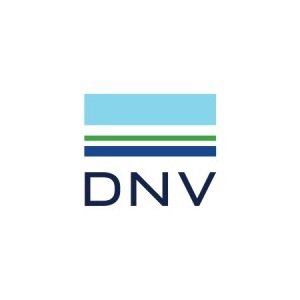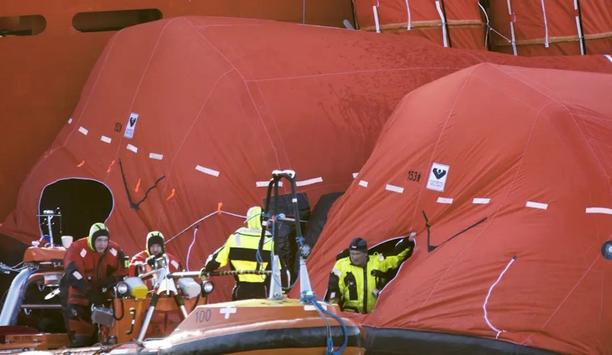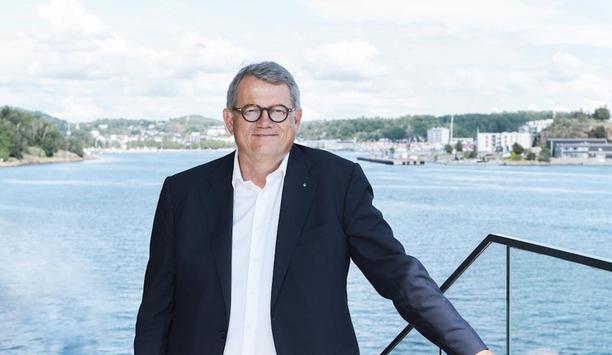DNV - Experts & Thought Leaders
Latest DNV news & announcements
SRC Group’s Methanol Superstorage solution has won The Royal Institution of Naval Architects Maritime Innovation Award 2025, recognising its contribution to the adoption of methanol as a mainstream marine fuel. Every year, a panel of RINA judges considers initiatives from academia, as well as industry before giving the prestigious award to the innovation considered the most significant in terms of advancing maritime vessel design, construction, and operations. Methanol superstorage Aligning with International Maritime Organisation targets to reduce greenhouse gas emissions over the coming decades and achieve Net Zero by or around 2050, a ship fuelled by green methanol could reduce carbon emissions by up to 95%. Methanol Superstorage is a unique, space-efficient methanol storage solution However, methanol has significantly lower volumetric energy content than HFO. Owners working with the fuel either need to bunker more frequently or factor in around 2.5 times the fuel storage capacity to produce equivalent energy. Methanol Superstorage is a unique, space-efficient methanol storage solution that will allow existing ships and newbuilds to play a full role in energy transition. Sandwich Plate System technology Conventionally, the tanks used to store low flash-point fuels on ships feature internal and external walls that are separated by cofferdams spanning a minimum of 600mm. Methanol Superstorage meets the storage challenge by replacing this with Sandwich Plate System (SPS) technology, where 25mm thick tank walls are comprised of internal and external steel surfaces connected by an elastomer core. Already approved in principle by Lloyd’s Register and RINA (Registro Italiano Navale), Methanol Superstorage boosts tank capacity on average by around 85% with minimal impact on the GA. CEO’s words Speaking at RINA ’s Annual Dinner, at the De Vere Grand Connaught Rooms, Covent Garden, London on 22 May, Hannes Lilp, CEO and Chair, SRC Group, said: “The SRC team is truly honoured to accept RINA’s Maritime Innovation Award, which considers developments in hydrodynamics and propulsion, structures and materials from across academia and industry.“ Hannes Lilp adds, “Given that our focus in growing SRC over the last 25 years has been on the complex ship project work we do day to day, it is especially rewarding to be recognised for the engineering innovation that has gone into developing Methanol Superstorage.” Rise of alternate fuels DNV’s latest Alternative Fuels Insight (AFI) figures show that ships using methanol accounted for 24 of the 49 orders placed for alternative fuel solution in April 2025. In March, DNV said that 60 methanol-fuelled ships were already in operation, with a further 340 on order. SRC has already undertaken detailed studies covering the use of the Methanol Superstorage solution on board cruise ships, container ships, ferries, tugs, offshore support vessels and yachts.
Sea trials are performed in northern waters – typically at depths of 200-300 metres off the coasts of Norway, the Shetland Islands, the Faroe Islands, and Iceland. Responsibility for conducting sea trials lies with the Development Test and Verification (DTV) department. During a heavy weather sea trial, test participants are stationed for more than two weeks in challenging conditions on a mother ship with a shared bath and toilet – in other words, a job demanding more than a fair share of perseverance. On the other hand, it’s also the epitome of VIKING’s values about saving lives. Seafarers by nature "It’s interesting that we can calculate and learn a great deal while on land, but you can never prepare for what you’ll encounter at sea – it’s often full of surprises and you risk getting bashed around by waves, currents, and other conditions." "It’s also amazing that we’re actually landlubbers, but strong seafarers by nature, and that’s a must because it’s incredibly demanding to participate in the sea trials," Knud-Erik Lausten, Engineering Team Lead, DTV. Kasper is a seasoned pro The newbies tagging along as observers, those who are more experienced and can perform tasks Knud-Erik generally divides the sea trial crew into three categories: The newbies tagging along as observers, those who are more experienced and can perform tasks on the deck, and the seasoned pros capable of doing the difficult work on fast rescue boats (FRB) and down in the liferafts. Kasper Grønne Larsen belongs to the latter category. “Many who come out here say that they never want to do it again – and we respect that. You have to be able to rely on each other when you’re working at sea. I think it’s exciting to be a part of the entire development process and to ultimately see first-hand how the product performs when it is needed in difficult weather conditions,” says Kasper Grønne Larsen, who joined VIKING over a decade ago and quickly ventured offshore to test safety equipment. The perfect test Knud Erik vividly recalls the last trip in an extensive series of sea trials that finally led to the approval of the VIKING LifeCraft™ as a Novel Life-Saving Appliance. “The sea trial involved testing how well the LifeCraft™ system performs in high winds, stormy seas, and extreme weather conditions. We launched the LifeCraft™ with the ship heading 3 knots up against the wind, exposing the system to the full force of the fierce weather in the most critical test phase. We then demonstrated – with a simulated dead ship condition – that the fully loaded system provides a safe and stable means of evacuation in both the weather and lee side for several hours.” Heavy weather sea trial facts VIKING strives for an average wave height of 3.5 metres and a wind force of 7-8 A sea trial requires considerable wave heights of at least 3.0 metres and a wind force of 6 on the Beaufort scale. VIKING strives for an average wave height of 3.5 metres and a wind force of 7-8 – otherwise known as a gale – for greater certainty that the weather conditions meet the SOLAS test requirements for several hours. A support ship accompanies the team in the test area and is responsible for ensuring that everything remains safe. LifeCraft™ survival craft “In addition, we quickly and successfully maneuvered the LifeCraft™ survival craft on both sides of the vessel to a safe distance, demonstrating their built-in flexibility to move rescue capacity to wherever it is most needed." "Simulating station-keeping while waiting for rescue, we performed a 24-hour controlled drift test in the battering seas with no damage sustained to the survival craft.” Significant wave heights LifeCraft™ was subjected to brutal wind gusts with speeds of up to 18 m/s Heavy weather is exactly what nature delivered at the testing location that we managed to track down in the North Sea between southern Norway and the United Kingdom. In fact, after being ballasted with 70 tons to simulate full capacity, the LifeCraft™ was subjected to brutal wind gusts with speeds of up to 18 m/s in addition to significant wave heights of between 3.6 and 4.6 metres. The perfect storm Towering peak waves of 10 metres greatly exceeded the required 3 metres needed for the trials, with the personnel from VIKING and DNV GL (attending on behalf of the Danish Maritime Authority) battling sea-sickness and heaving decks to conclude the tests. The trial also afforded crew members the opportunity to demonstrate, under extreme conditions, the flexibility, and capability of the chute arrangements that provide a controlled vertical passage from the embarkation point to the survival craft. All landed safely at the expected evacuation speed, dry and unbrushed by the elements.
As a rarity among Norway’s top business pioneers, Morten Fon has spent his entire 36-year career with one company, taking various positions and overseas assignments before being tapped as Jotun’s President and CEO in 2005. Since then, the Norwegian company has experienced almost uninterrupted growth to become one of the fastest growing suppliers in the global paints and coatings industry. “It’s been a remarkable journey,” says Fon. “In addition to a fantastic organisation, Jotun benefits from the continuity of our owners, the Gleditsch family, who have allowed us the freedom to think in years, not quarters,” he says. “This has helped us succeed in the highly cyclical shipping industry.” Deep roots in shipping Fon and the senior management team work hand in hand with Jotun’s Board of Directors Fon and the senior management team work hand in hand with Jotun’s Board of Directors, led by Chairman Odd Gleditsch d.y. He is the grandson of Odd Gleditsch sen., who established the company in 1926. “Today, we sell decorative paints and protective and powder coatings to a broad range of customers, but our roots are in the shipping industry,” says Fon. “In fact, we opened our Group headquarters and R&D centre here in Sandefjord in 2020 on the same piece of land as our first factory, which was built across the fjord from a shipyard. That shipyard closed in 1986, but we are still here.” A global organisation With close to 11,000 employees representing 93 different nationalities active in more than 100 countries worldwide, Jotun is a truly global organisation. Fon credits the company’s historic ties to the Norwegian shipping cluster for the company’s international success. “Shipping is a global industry, so it’s no accident that about half of our global network of 40 factories, many of which have been in operation for decades, were built near ports and shipyards. Today, we supply marine coatings to about a quarter of the world’s merchant fleet and deliver to about 1,400 ports, all over the world.” A history of innovation Jotun’s long-term investments in R&D have also helped the company differentiate itself from the competition Jotun’s long-term investments in R&D have also helped the company differentiate itself from the competition. “Jotun’s focus on innovation is part of our DNA, enabling us to develop several game-changing products over the years,” says Fon. “In addition to a network of regional R&D centres, supported by local laboratories and various test sites, we collaborate with owners, shipyards, and other stakeholders to meet or anticipate the evolving needs of the industry.” ”This process has not only led to innovations that have changed how the industry sees marine coatings, but how we see our offering.” Jotun’s Hull Performance Solutions (HPS) Jotun’s Hull Performance Solutions (HPS) is one such innovation. Launched in 2010, HPS gives owners and operators access to Jotun’s best antifouling technologies, unmatchable technical service, intelligent hull condition management and credible performance guarantees. “I remember thinking at the time that if we succeed with HPS we would change the industry,” says Fon. “It took a lot of work, but today, HPS is recognised as the industry’s most effective antifouling solution, providing owners and ship managers with the ability not only to lower fuel costs and corresponding emissions, but document their results.” From supplier to partner With more than 2000 applications to date, HPS has proven a commercial success With more than 2000 applications to date, HPS has proven a commercial success. But HPS also changed Jotun. “Thanks to HPS, we were able to gather data on hull performance taken from ships in operation, and as more customers signed up to HPS, we were able to collect the industry’s most complete historical dataset on hull efficiency,” Fon says. “This allowed us to develop fouling risk algorithms and performance analytics tools to create a suite of digital services to help customers improve hull performance.” Pressure to improve environmental performance Fon adds that as the industry faces growing pressure from cargo owners and regulators to improve its environmental performance, customers are increasingly recognising the vital role antifoulings play in reducing emissions. “Thanks to HPS, we learned that we have a lot more to offer the shipping industry than steel protection,” he says. “Put another way, they don’t want paint, they want clean hulls.” Hull skating solutions This shift in thinking would produce Jotun’s most daring innovation yet: Hull Skating Solutions This shift in thinking would produce Jotun’s most daring innovation yet: Hull Skating Solutions (HSS.) Developed in a partnership Kongsberg Maritime, Wallenius Wilhelmsen, Semcon, Telenor and DNV, HSS takes hull protection to the next level. HSS consists of five components: A high-performance antifouling coating (SeaQuantum Skate), proactive condition monitoring, high-end technical service and performance guarantees. But what makes HSS unusual is an advanced underwater robotic cleaning unit, the Jotun HullSkater. Industry’s first remotely operated robotic device “Jotun HullSkater is the industry’s first remotely operated robotic device that has been purposely designed for proactive hull cleaning,” he says. “By removing slime and fouling before organisms have time to firmly attach to the hull, the Hull Skater not only helps ship-owners to reduce fuel costs and corresponding emissions, it helps vessels stay in compliance with increasingly strict local and global regulations designed to protect marine ecosystems from invasive aquatic species.” Introducing disruptive technology Jotun’s legacy of innovation has given the organisation the confidence to make bold decisions Fon acknowledges that a remotely controlled robotic hull cleaning unit may seem an unusual investment for a paints and coatings company. But he insists that Jotun’s legacy of innovation has given the organisation the confidence to make bold decisions. “We recognise that the Hull Skater is a disruptive technology. However, if we hadn’t done this, someone else would have,” he says. Early success So far, Jotun’s investment in Hull Skating Solutions is paying off. Now in use on about 30 vessels, the concept has exceeded expectations. “Our customers already understand the benefits of a clean hull, but with growing concerns about ocean pollution and the threat of invasive species, we believe that proactive hull cleaning will allow owners to ‘future proof’ their vessels against pending regulations,” says Fon. “Jotun HullSkater may be the most innovative antifouling system available to the market today, but our focus on supporting our customers hasn’t changed in almost a century. And to me, that is something to celebrate!”
Insights & Opinions from thought leaders at DNV
More than almost any trend, decarbonisation is driving the future of maritime. That reality alone makes decarbonisation the perfect topic for our first-ever Expert Panel Roundtable column. Traditional maritime fuels, like heavy fuel oil, release harmful pollutants that contribute to air pollution and have adverse health effects. We have to do better, and discussions in the maritime industry centre on which combination of alternative fuels and other technologies can solve the shorter- and longer-term challenges of decarbonisation. For an update on the various approaches, we asked our Expert Panel Roundtable: What are the latest maritime technology trends in decarbonisation?
The maritime industry is taking important steps to improve cybersecurity, catching up rapidly by introducing other industries' best practices into information technology (IT) and operational technology (OT) onboard vessels. Work remains to be done to ensure a cyber-resilient worldwide fleet of maritime operations. The way forward is through collaboration among all major stakeholders. Remote-controlled and autonomous ships In the future, the marine industry will increasingly use remote-controlled and autonomous ships and infrastructure. One can imagine multi-ship, multi-infrastructure hybrid scenarios where a software failure or a cyber-attack could result in widespread damage. “Protecting this advanced marine industry will drive the need for even higher levels of cybersecurity, reliability, and robustness of marine automation systems and software,” says Svante Einarsson, Head of Maritime Cyber Security Advisory, DNV Cyber. Cybersecurity insights CyberOwl complements DNV Cyber with advanced analytics and threat management for maritime vessels Einarsson shares additional insights into cybersecurity for the maritime industry in our recent interview. DNV expanded its cybersecurity capabilities by acquiring Applied Risk in 2021 and Nixu in 2023, forming DNV Cyber with over 500 experts. This merger enhances maritime cybersecurity by integrating IT and industrial control system security services, offering comprehensive solutions from risk assessment to incident response. CyberOwl complements DNV Cyber with advanced analytics and threat management for maritime vessels, ensuring real-time threat monitoring and support to sustain regulatory compliance. Maritimeinformed.com: What are the cybersecurity vulnerabilities in the maritime market? What are the possible consequences and/or worst-case scenarios? Einarsson: The maritime industry faces several cybersecurity vulnerabilities, including the integration of IT and OT systems, unsecured Internet of Things (IoT) devices, outdated software, weak authentication, and human factors like phishing. The consequences of breaches can be severe, such as operational disruption, data theft, ransomware attacks, cyber-physical attacks, and supply chain disruption. A worst-case scenario includes hybrid incidents that compromise both IT and OT systems at the same time within highly trafficked areas (such as a port). Depending on the available time and alternative means, the vessel might run aground resulting in major oil spills, environmental disasters, and/or significant loss of life. These vulnerabilities and potential impacts highlight the critical need for robust cybersecurity measures in the maritime sector. Maritimeinformed.com: What is the role of regulations when it comes to cybersecurity in the maritime market, including IMO, IACS, and critical infrastructure regulations? How do regulations drive better cybersecurity practices? The EU’s NIS2 directive enforces robust cybersecurity strategies and incident reporting Einarsson: Regulations play a crucial role in maritime cybersecurity by setting global standards and ensuring compliance. The International Maritime Organisation (IMO) mandates cyber risk management in Safety Management Systems, while the International Association of Classification Societies (IACS) requires cybersecurity integration in systems and ships throughout the lifecycle of a vessel for new builds contracted after July 1, 2024. The EU’s NIS2 directive enforces robust cybersecurity strategies and incident reporting. These regulations drive better practices by standardising frameworks, holding organisations accountable, promoting holistic risk management, enhancing transparency, and fostering continuous improvement. This comprehensive regulatory approach forces all stakeholders in the industry (yards, vendors, and ship managers) to act and work together to implement effective cyber resilience. Maritimeinformed.com: How does greater awareness boost cybersecurity? What is the role of near misses in driving cyber awareness and investments? Einarsson: Greater awareness boosts cybersecurity by educating individuals and organisations about potential threats, leading to better prevention and response strategies. It fosters a culture of vigilance, reducing the likelihood of successful attacks. Near misses play a crucial role by highlighting vulnerabilities and demonstrating the potential impact of cyber threats without causing actual harm. These incidents drive investments in cybersecurity by showcasing the need for robust defences, and well-planned responses, and encouraging proactive measures to prevent future breaches. Maritimeinformed.com: What are the pitfalls of over-confidence and under-preparation when it comes to cybersecurity? Einarsson: Overconfidence in cybersecurity can lead to complacency, ignoring potential threats, and underestimating attackers. For example, relying on boundary protection only, and believing that a system is impenetrable might result in neglecting regular updates and patches, leaving it vulnerable to exploits. Under-preparation, on the other hand, means inadequate de fences, response plans, and drills. An example is the 2017 Equifax breach, where failure to patch a known vulnerability led to the exposure of sensitive data of 147 million people. Both pitfalls can result in significant financial and reputational damage. Maritimeinformed.com: What is the role of technology advancements in driving the need and awareness of cybersecurity (e.g., the impact of digitisation, decarbonisation, automation, etc.)? Digitisation and automation support decarbonisation also increase the need for cybersecurity Einarsson: Decarbonisation is one of the key shaping factors in maritime today. Technology advancements like digitisation and automation support decarbonisation but also increase the need for cybersecurity by expanding the attack surface and introducing new vulnerabilities. As industries adopt remote maintenance, IoT, artificial intelligence (AI), and other technologies, the complexity and connectivity of systems grow, making them more susceptible to cyber threats. An example is how scrubber systems with modern technologies such as remote connectivity are retrofitted onboard older vessels today, creating a new and potentially unmanaged gateway to the control systems onboard the vessel. In other words, cybersecurity enables digitisation and decarbonisation. Maritimeinformed.com: What is the labor situation when it comes to the skillsets needed for cybersecurity excellence? Is there a shortage of expertise and how can it be addressed? Einarsson: The cybersecurity industry faces a significant skills shortage, with a very large number of positions unfilled globally. This gap is driven by the rapid evolution of cyber threats and the increasing complexity of digital environments. To address this, organisations should adopt skills-based hiring, offer continuous training and upskilling, and create clear career paths. Attracting diverse talent and collaborating with educational institutions can also help bridge the gap. Emphasising both technical and soft skills is crucial for developing a robust cybersecurity workforce. Many times the best option is to combine different competencies of several people into an aligned team, such as superintendents with OT system and operation expertise with cybersecurity and IT fleet experts. Maritimeinformed.com: What is the emerging role of AI in cybersecurity, such as the ability to anticipate attacks before they happen? AI-driven tools can predict and anticipate attacks by recognising early warning signs, allowing teams to address vulnerabilities Einarsson: AI can significantly enhance cybersecurity teams' effectiveness by providing advanced threat detection and predictive analytics. Machine learning algorithms analyse vast amounts of data to identify patterns and anomalies that may indicate potential cyber threats. AI-driven tools can predict and anticipate attacks by recognising early warning signs, allowing teams to address vulnerabilities proactively. Additionally, AI automates routine tasks, freeing up human experts to focus on more complex issues. Human teams can assess AI-generated results, ensuring accuracy and context, and make informed decisions. Real-time threat intelligence and automated response systems ensure quicker mitigation of incidents, ultimately strengthening the overall security posture and reducing the likelihood of successful cyber-attacks. Maritimeinformed.com: What is the impact of geopolitics on cybersecurity? How does the geo-political situation contribute to risks? Einarsson: Geopolitics significantly impacts cybersecurity by increasing the frequency and severity of cyber-attacks. Conflicts like the Russia-Ukraine war have led to coordinated cyber and hybrid offensives, targeting critical infrastructure globally. Geopolitical tensions contribute to risks by creating an environment where state and non-state actors exploit vulnerabilities and accessible assets for espionage, sabotage, and disinformation. The most obvious related threat in the maritime domain is GPS and AIS spoofing which is very common in military active areas. Incidents have already happened where the untrained crew has had their ship impounded after being misled into foreign state waters.
We are in the midst of a decisive decade when it comes to the future of maritime. Facing a long-term goal of achieving net-zero emissions by 2050, the industry needs to make more informed and science-based decisions, and a new level of collaboration and flexibility will be needed among all maritime stakeholders. DNV’s Maritime Forecast to 2050 report provides a deep dive into shipping’s decarbonisation journey. Energy Transition Outlook 2023 The Energy Transition Outlook 2023 is the latest industry report focusing on the future of shipping and the uncertain route to getting there. DNV is the world’s pioneering classification society and a recognised advisor for the maritime industry. Between 2030 and 2050, technologies will have to be implemented along the path to net zero In the near term, between now and 2030, reducing energy consumption will go a long way toward meeting the required carbon reductions, according to the report. However, in the longer term, between 2030 and 2050, newer technologies will have to be implemented along the path to net zero. New pilot programmes "We try to have an overview of what's important and stay abreast of what is being discussed in the industry," says Eirik Ovrum, Principal Consultant, DNV Environment Advisory and lead author of the report. "This year, we focused on discussing technologies we haven't focused on before. We have to consider all of them." New pilot programmes including on-board carbon capture and nuclear propulsion will provide insight into how workable these strategies are on a larger scale and in a longer timeframe. Technological commercialisation A lot of technology will have to be developed, demonstrated, and commercialised over the next decade" "In this decade, we will have to develop new technologies and demonstrate performance, and then after that, we need to use those technologies on a larger scale,” says Ovrum. “Technological commercialisation is uncertain until we show we can make it work. But it is necessary. A lot of technology will have to be developed, demonstrated, and commercialised over the next decade." Decarbonisation focus for 2030 The near-term decarbonisation focus for 2030 is to reduce carbon emissions by 20%, which is “ambitious, bordering on the unrealistic,” says Knut Orbeck-Nilssen, DNV’s CEO, Maritime. “The outlook is challenging, but I remain an optimist,” he says. “Shipping has managed great challenges before. We need collaboration both within shipping and across sectors with those who produce and distribute the energy. Public and private partnerships can make a good contribution.” Use of alternative fuels Achievements toward the goal include a rapid growth in ships that can use alternative fuels “The clock is ticking louder on efforts to identify, define, and resolve barriers to successful and safe decarbonisation,” says Orbeck-Nilssen. Achievements toward the goal include a rapid growth in ships that can use alternative fuels, such as methanol and LNG (liquified natural gas). Carbon-neutral fuels In the long term, a range of technologies will be necessary, beyond the use of alternative fuels. The shipping industry will compete for the availability of carbon-neutral fuels with aviation, road transportation, and other industries. The shipping market will require an estimated 30-40% of the cross-sector carbon-neutral fuel supply in 2030. Carbon capture and storage The technology captures the carbon in the fuel before CO2 is emitted to the atmosphere through the exhaust Onboard carbon capture and storage can reduce the demand for carbon-neutral fuels and avoid broader market competition for sustainable biomass and renewable electricity. The technology captures the carbon in the fuel before CO2 is emitted to the atmosphere through the exhaust, thus allowing for continued use of carbon-rich fossil energy (but with significantly reduced CO2 emissions). Nuclear-powered ships Nuclear-powered ships are another approach, which is a proven technology used in navies and icebreakers. The technology would also reduce the competition for biomass and renewable electricity, but barriers exist to the application of nuclear power to merchant vessels. Pilot studies are planned for the early 2030s to assess the long-term feasibility of nuclear-powered ships. According to the DNV 2023 report, nuclear propulsion can be a competitive option if reactor costs are in the lower range of historical costs for land-based nuclear power plants. Accelerating the green shipping corridors Green shipping corridors can accelerate the use of carbon-neutral fuels by allowing barriers to be identified The continuing development of “green shipping corridors” will facilitate the application of decarbonisation strategies throughout the maritime value chain. A “green corridor” is a shipping route on which zero-carbon emissions ships and other emission reduction programmes are deployed, enabled by public and private actions and policies. Green shipping corridors can accelerate the use of carbon-neutral fuels by allowing barriers to be identified and overcome in a more targeted and practical way, rather than on a global scale. Wind-assisted propulsion and air lubrication systems Technologies such as wind-assisted propulsion and air lubrication systems can also play a role in the decarbonisation effort. Air lubrication reduces the resistance between a ship and the sea around its hull, thus lowering energy consumption. Other factors include digital tools, and fleet deployment and optimisation. “The 2020s is proving to be the decisive decade for decarbonisation of shipping,” says Ovrum. Decisions and strategies developed in the next few years will be decisive in meeting the 2030 and 2050 decarbonisation goals. Ways to overcome challenges To meet the challenges, Ovum says shipowners should: Reduce energy consumption now; Consider all decarbonisation options; Focus on fuel flexibility; and Consider long-term fuel strategies.
















































